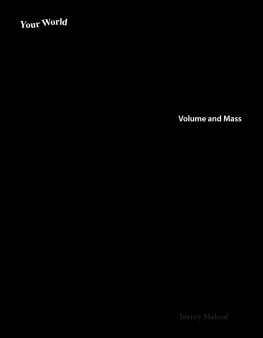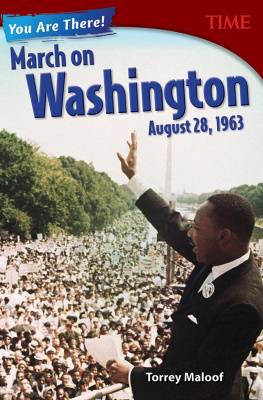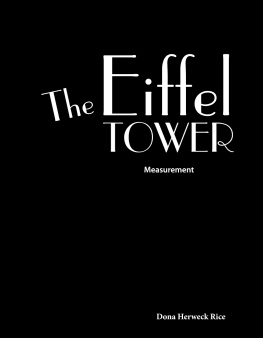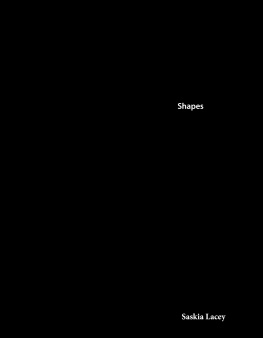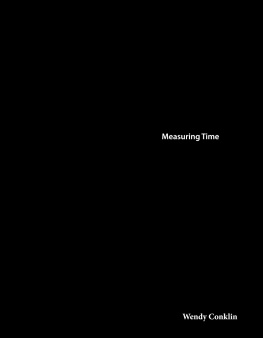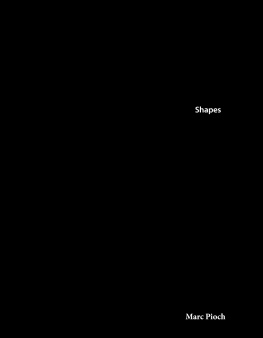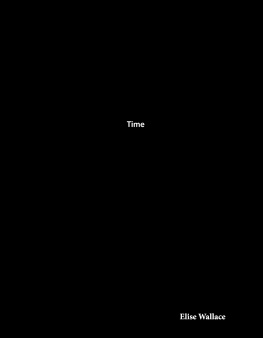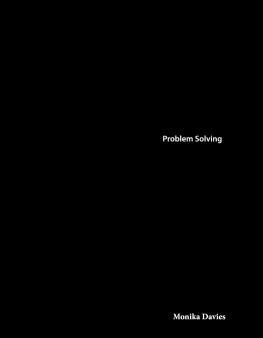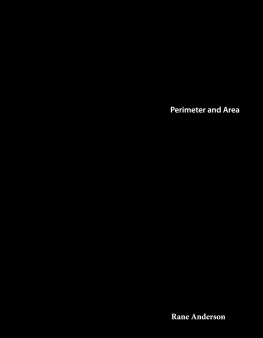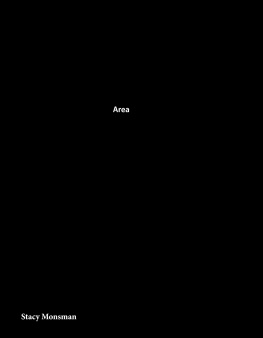Torrey Maloof - Your World: Investigating Measurement: Volume and Mass
Here you can read online Torrey Maloof - Your World: Investigating Measurement: Volume and Mass full text of the book (entire story) in english for free. Download pdf and epub, get meaning, cover and reviews about this ebook. year: 2017, publisher: Triangle Interactive, LLC, genre: Children. Description of the work, (preface) as well as reviews are available. Best literature library LitArk.com created for fans of good reading and offers a wide selection of genres:
Romance novel
Science fiction
Adventure
Detective
Science
History
Home and family
Prose
Art
Politics
Computer
Non-fiction
Religion
Business
Children
Humor
Choose a favorite category and find really read worthwhile books. Enjoy immersion in the world of imagination, feel the emotions of the characters or learn something new for yourself, make an fascinating discovery.
- Book:Your World: Investigating Measurement: Volume and Mass
- Author:
- Publisher:Triangle Interactive, LLC
- Genre:
- Year:2017
- Rating:5 / 5
- Favourites:Add to favourites
- Your mark:
- 100
- 1
- 2
- 3
- 4
- 5
Your World: Investigating Measurement: Volume and Mass: summary, description and annotation
We offer to read an annotation, description, summary or preface (depends on what the author of the book "Your World: Investigating Measurement: Volume and Mass" wrote himself). If you haven't found the necessary information about the book — write in the comments, we will try to find it.
Your World: Investigating Measurement: Volume and Mass — read online for free the complete book (whole text) full work
Below is the text of the book, divided by pages. System saving the place of the last page read, allows you to conveniently read the book "Your World: Investigating Measurement: Volume and Mass" online for free, without having to search again every time where you left off. Put a bookmark, and you can go to the page where you finished reading at any time.
Font size:
Interval:
Bookmark:
0covercover.xhtmlYour world Investigating Measurement Volume and Mass Torrey Maloofcover3page0003page0003.xhtml44page0004page0004.xhtmlTable of Contents Mealtime Measuring 4 The Same Language 6 Take a Good Guess 9 Daily Decisions 13 Go Forth and Measure 26 Problem Solving 28 Glossary 30 Index 31 Answer Key 3255page0005page0005.xhtmlMealtime Measuring How do you measure things when you help cook dinner? Do you use cups? Do you use spoons? Do you add a pinch of something to a mixing bowl? You probably do not measure everything the same way. The way you measure things depends on the units that are needed. And before you start cooking, you need to make sure you have what you need. When people shop for ingredients, they must make sure they buy the right amounts. Otherwise, they will not be able to follow their recipes. Luckily, most foods have labels. Those labels list key measurements. For instance, the label on a bag of rice will tell you how much rice is in the bag. The label on a bottle of water will tell you how much water is in the bottle. It is important to know what these numbers mean. Numbers are important inside and outside of the kitchen.66page0006page0006.xhtmlLet's77page0007page0007.xhtmlThe Same Language Can you speak more than one language? Or, do you know someone who can speak a language that you don't know? Whatever the case may be, there is one language that is known all over the world-math! Math is a universal language. We can use numbers to talk about the world around us. How do numbers help us describe our world? Well, numbers are often used to describe measurements. The weight of a solid object depends on how much matter is in that object. That amount is called mass. The more mass things have, the heavier they will be. Liquids are measured differently, though. They are measured by the amount of space they take up. That amount is called volume. While numbers are all the same, units vary. The metric system has units that can be used to talk about temperature, length, mass, and volume. It is based on the number 10. Metric units such as kilograms (kg) and grams (g) measure mass. Liters (L) and milliliters (mL) are common units used to measure volume. A pinch of salt is less than 1 gram. A D-battery is about 150 grams.88page0008page0008.xhtmlA drop of water is less than 1 milliliter. A bag of apples is about 1 kilogram. A bottle of soda is about 1 liter. Let's99page0009page0009.xhtml1010page0010page0010.xhtmlTake a Good Guess What if you dont have time to find an exact measurement? Take breakfast, for example. Do you measure the milk before pouring it into your cereal bowl? Or, do you just pour until it looks right? Chances are that you do the latter. But this is more than a guess. Its based on what you know. The bowl holds a certain amount of liquid. The dry cereal is already taking up some room in that bowl. That information can be used to pour the right amount of milk. This is called estimating. If your estimate is wrong, your breakfast might not be what you hoped for. Estimation is used every day. People estimate how long it will take to get to school or work. Shoppers estimate how much groceries will cost. These are not random guesses. They are based on information that is known.1111page0011page0011.xhtmlIt is helpful to estimate with familiar objects. Imagine holding a large dictionary. Does it feel light? Heavy? It actually has a mass of about 1 kg. Knowing this can help you make a good guess about the mass of another object. For example, how many dictionaries would have about the same mass as a cat? If your guess is about two dictionaries, then you made a pretty good guess. It works with volume, too. Think about a teapot. A teapot holds about 1 L of water. How many liters would it take to fill a bathroom sink? Imagine pouring water from a teapot into a sink. How many teapots would it take to fill it? If your guess is around eight full teapots, then you are getting good at this! Two dictionaries have about the same mass as one cat.1212page0012page0012.xhtmlA bathroom sink holds about eight teapots worth of water. let's1313page0013page0013.xhtmlAlthough backpacks may cause backaches, they don't cause scoliosis, the condition seen in this X-ray.1414page0014page0014.xhtmlDaily Decisions Do you think estimating is only used in math class? Maybe you believe that measuring only happens in a science lab. Or, perhaps you think real-world math is only found in the kitchen. Think again! Estimating can help you make decisions in everyday life. Backbreaking Backpack Lynn loves books. She enjoys reading and likes to learn new things. Her favorite books are about history. The school librarian helps her choose a new topic each week. This week, she is reading about the pyramids in Egypt. She is learning many cool things about mummies and pharaohs. But, her love of books is causing a problem. History books can be big books! Last week, Lynns back started to hurt. The librarian thinks her backpack is causing the pain. She thinks it is too heavy for her. But Lynn disagrees. She estimates that her backpack has a mass of about 2 kg. The librarian estimates that Lynns backpack has a mass of about 5 kg. She asks Lynn to measure the mass of her backpack. She wants her to share the measurement with the school nurse.1515page0015page0015.xhtmlLynn begins to empty her backpack. There is a lot of stuff! As she takes each item out, she begins to think that her estimate of 2 kg may be too low. But, she still does not think the total mass is more than 5 kg. Lynn makes a list of the items in her backpack. Some of the items are not very heavy. She has things like pencils, a homework folder, and some money. She does not include these on the list. She knows they have a mass of only a few grams or less. But, Lynn does include her three books, her water bottle, and her laptop. She estimates the mass of each object to be about 1 kg. She adds the five items together. The total mass of her backpack is about 5 kg. The librarian was right! The nurse agrees that Lynn has too much in her backpack. Rather than ditch her books, Lynn buys a backpack with wheels. Problem solved!1616page0016page0016.xhtmlLets Items1717page0017page0017.xhtml1818page0018page0018.xhtmlHydrated and Healthy At school last week, Ruby learned all about nutrition. A doctor talked to her class. The doctor told students about the wholesome foods they should be eating. She talked to them about exercise, too. Healthy food and activity can make you feel good inside and out, she said. The doctor also talked about drinking water. She explained why staying hydrated is a good thing. Luckily, Ruby already runs a lot. Plus, she plays on her schools soccer team. Both are great workouts! She makes good food choices, too. But there is one thing Ruby does not do drink enough water. Ruby wants to make a change. She wants to be as healthy as possible. She has a big soccer game coming up, and she wants to be in tip-top shape. Ruby is determined to start drinking more water.1919page0019page0019.xhtmlThe doctor told students that they should drink 2 L of water a day. Ruby decides to put her math skills to use. She plans to make a table. The table will help her make sure she is drinking enough water each day. Ruby knows there are 1, 000 mL in 1 L. So, she must drink 2, 000 mL of water each day. Ruby has two water bottles that are different sizes. She has a small green one. It holds 500 mL. She also has a big silver one. It holds 800 mL. She uses the silver one when she plays soccer because it holds more water. She gets very thirsty when she dribbles the ball up and down the field under the hot sun. Ruby thinks about the total volume of each water bottle. Then, she makes her table.2020page0020page0020.xhtmlLet's Days2121page0021page0021.xhtmlDog Days of Summer Trevors dog, Wally, has been his best friend since he was a little boy. Wally looks and acts like a teddy bear. He is loving and fluffy. He is also funny. He likes to do silly things to make Trevor laugh. One time, he rolled around in a large mud puddle for hours. When he was done, only Wallys eyes could be seen under the layers of thick mud. Wally is always there for Trevor. And Trevor is always there for Wally. But, Trevor is going on a trip this summer. He is going to Europe with his parents. They will be gone for two weeks. Trevor wants to make sure he leaves enough food and medicine for Wally with the dogsitter. Wally eats a certain amount of food every day. He also needs a small amount of medicine added to his water. To do this, Trevor uses a dropper. He knows that they will need to leave instructions for the dogsitter.2222page0022page0022.xhtmlTrevor and Wally2323page0023page0023.xhtmlTrevor works with his parents to plan how much food Wally should get each day. If Wally does not get enough food, his health will suffer. But if he eats too much, he could become overweight. His heart or skin might not be healthy. He could also get arthritis. Too much food could cause a lot of problems. So, Trevor wants to make sure Wally gets the right amount of food. How much food should Wally get? Trevor does not just dump food into Wallys bowl. He uses a special scale to find its mass first. Wally must eat 200 g of food at each meal. And, Trevor feeds Wally twice a day. Now, Trevor has to figure out how much dog food to buy for Wally. There has to be enough for the two weeks that Trevor will be gone.2424page0024page0024.xhtmlLet's2525page0025page0025.xhtml2626page0026page0026.xhtmlNow, Trevor and his parents need to arrange for Wally to get his medicine. He has a brand-new bottle of it. But, Trevor is not sure there will be enough. He checks the label. It says that the total volume is 30 mL. Trevor uses a dropper to give Wally his medicine. The dropper holds 1 mL of liquid. Trevor gives Wally two full droppers. That means Wally takes 2 mL of medicine each day. Trevor will be gone for two weeks. So, he multiplies 14 days by 2 mL. That is a total volume of 28 mL. Is there enough medicine? Yes, because 28 mL is less than 30 mL. Trevors parents will not have to buy another bottle of Wallys medicine for the dogsitter. Let's2727page0027page0027.xhtmlGo Forth and Measure! Now, the metric system is in your tool chest. What will you measure next? There are so many options. What is the mass of a peanut butter and jelly sandwich? Does a ham sandwich have greater mass? Do you think their masses should be measured in grams or kilograms? Which sandwich has the most mass?2828page0028page0028.xhtmlWhat about liquids? Which do you think holds more liquid : a coffee mug or a teacup? How many glasses of milk are there in a carton? You have the tools to solve these problems, too liters and milliliters. Think about familiar objects and which ones you can use to estimate. You can do it! The more you practice, the better you will be at measuring and estimating in your everyday life. Which glass holds more liquid?2929page0029page0029.xhtmlProblem Solving Sela is going on a weekend trip with her dad. He is a pilot, and he is flying them to a campground. They will be able to hike, relax, and read. Sela is looking forward to painting some of the natural scenes. Selas dad says that her carry-on bag cannot have a mass of more than 10 kg. Sela wants to bring a lot of stuff! She needs to plan carefully. Help Sela pack her bag. 1. Find the total mass of all of Selas items. 2. What is the difference between the heaviest item and the lightest item? 3. List two combinations of items that Sela could pack that would keep her at or under the 10-kilogram limit. Which option would you recommend to Sela? Why?3030page0030page0030.xhtmlItems Sela Wants to Bring Item Mass books 3 kg hiking boots 2 kg laptop computer 2 kg painting supplies 4 kg jeans 3 kg3131page0031page0031.xhtmlGlossary arthritis a disease that causes stiffness, swelling, and soreness in joints estimating guessing based on observations and information grams metric units of mass that are equal to one thousandth of a kilogram hydrated having enough water kilograms metric units of mass that are equal to 1, 000 grams liters metric units of volume that are equal to 1, 000 milliliters mass the amount of matter in something matter anything that has mass and takes up space metric system a system of measures and weights that includes kilograms and liters milliliters metric units of volume that are equal to one thousandth of a liter nutrition the process of eating the right kind of food in order to be healthy universal the same in all places volume the amount of space that is filled by something3232page0032page0032.xhtmlIndex estimate, grams (g), kilograms (kg), liquids, liters (L), mass, matter, measure, metric system, milliliters (mL), nutrition, solid, volume,3333page0033page0033.xhtmlAnswer Key Let's Explore Math page 5 : 1. The unopened box is heavier because it has more cereal in it. 2. Measure the mass of each box. Then, subtract the lighter mass from the heavier mass. page 7 : 1. Liter 2. Gram 3. Milliliter 4. Kilogram page 11 : 1. About 50 L 2. About 100 L 3. About 1 L 4. Less than 1 L page 15 : 1. 5, 000 g 2. No, because the estimate is too high. page 19 : 1. 2, 100 mL 2. Ruby met her goal on Tuesday, Wednesday, Friday, Saturday, and Sunday. She did not meet her goal on Monday or Thursday. 3. 14, 500 mL page 23 : 1. 400 g 2. 5, 600 g 3. No, one bag will not be enough for two weeks because 5, 000 is less than 5, 600. page 25 : 1. 2 mL 2. 4 bottles Problem Solving 1. 14 kg 2. 2 kg 3. Answers will vary but may include : Option 1 books, laptop, easel; Option B books, boots, laptop, jeans; Option B is better because Sela will need boots and jeans.3434page0034page0034.xhtmlMath Talk 1. Name two metric units. What can they be used to measure? 2. What is the difference between an estimate and an exact measurement? When can they be used? 3. How many kilograms do you think you can lift? Why do you think so? 4. How is measuring a solid different from measuring a liquid? How is it similar? 5. The metric system is based on the number 10. Why do you think this number is used? 6. How would you design a measurement system for solids and liquids? How would you convince others to agree with your system?3535page0035page0035.xhtmlyour world investigating measurement Volume and Mass How much sports drink can fit in a plastic bottle? How many books can fit in a backpack? Do large objects weigh more than small objects? Explore some real-life situations where being able to make exact measurements or form reasonable estimates can really come in handy. Measurement and Data36
Next pageFont size:
Interval:
Bookmark:
Similar books «Your World: Investigating Measurement: Volume and Mass»
Look at similar books to Your World: Investigating Measurement: Volume and Mass. We have selected literature similar in name and meaning in the hope of providing readers with more options to find new, interesting, not yet read works.
Discussion, reviews of the book Your World: Investigating Measurement: Volume and Mass and just readers' own opinions. Leave your comments, write what you think about the work, its meaning or the main characters. Specify what exactly you liked and what you didn't like, and why you think so.

